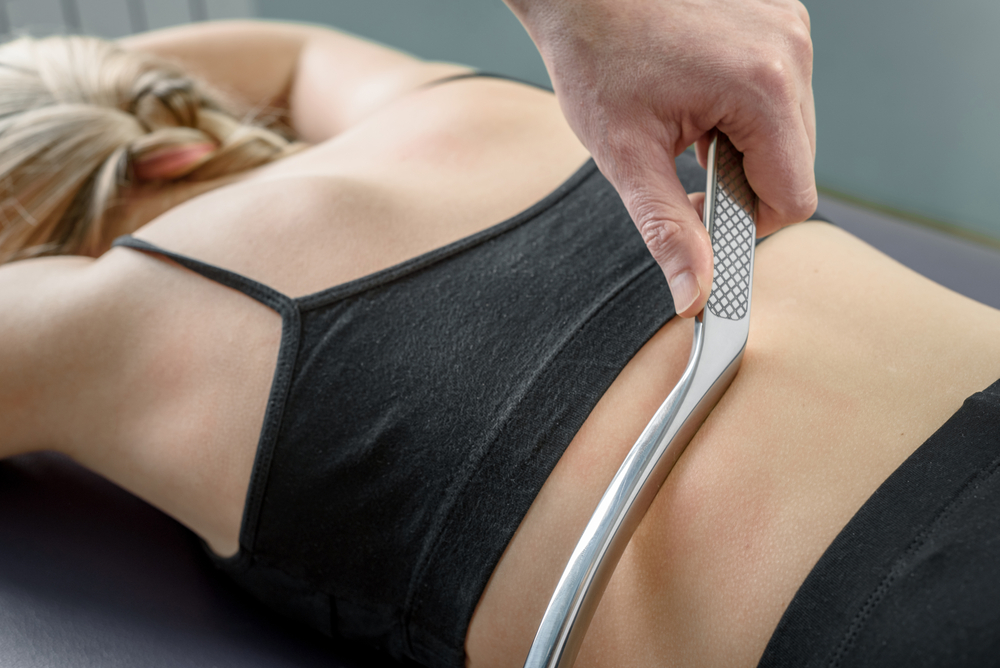At Butler Spine & Sport, we understand that muscle tension and soft tissue restrictions can significantly impact your daily activities and athletic performance. Muscle scraping, also known as instrument-assisted soft tissue mobilization (IASTM), is an effective technique that helps break down adhesions, increase blood flow, and promote optimal muscle function. Our specialized approach combines traditional methods with modern sports medicine principles to deliver exceptional results for athletes and active individuals.
Muscle Scraping
Understanding Muscle Scraping
Muscle scraping is a therapeutic technique that uses specialized tools to detect and treat areas of soft tissue restriction or fibrosis. This method involves carefully gliding smooth, ergonomic instruments across the skin to identify areas of tissue dysfunction and apply precise pressure to promote healing. The technique works by stimulating your body’s natural inflammatory response, which helps break down scar tissue and adhesions while promoting the formation of new, healthy tissue alignment.
Benefits of Muscle Scraping
- Accelerated Tissue Healing
- Enhanced Neuromuscular Function
- Targeted Scar Tissue Reduction
- Optimized Fascial Health
- Decreased Muscle Tension
Accelerated Tissue Healing
Muscle scraping stimulates your body’s natural healing mechanisms through controlled micro-trauma to the treated area. This therapeutic stress triggers increased blood flow and cellular activity, helping your tissues repair more efficiently. The technique enhances the delivery of nutrients and oxygen to damaged areas while promoting the removal of metabolic waste products. This combination of effects helps speed up your recovery from both acute injuries and chronic conditions.
Enhanced Neuromuscular Function
By breaking down restrictive tissue patterns, muscle scraping helps restore proper communication between your muscles and nervous system. This improved neuromuscular connection leads to better muscle activation and control during movement. The technique helps reset dysfunctional movement patterns and muscle recruitment strategies, allowing your body to function more efficiently in daily activities and athletic performance.
Targeted Scar Tissue Reduction
Muscle scraping excels at breaking down and remodeling problematic scar tissue that can develop after injuries or surgery. The specialized tools allow practitioners to detect and treat even deep adhesions that restrict normal tissue mobility. This precise approach helps restore proper tissue flexibility and function, preventing the compensatory patterns that often develop around scarred areas.
Optimized Fascial Health
Your body’s fascial network plays a crucial role in movement and function, and muscle scraping helps maintain its optimal condition. The technique helps hydrate and mobilize fascial tissues, preventing the restrictions that can lead to pain and decreased mobility. Regular treatments help ensure your fascial system maintains its natural elasticity and gliding properties, supporting better overall movement quality.
Decreased Muscle Tension
Muscle scraping provides effective relief from chronic muscle tension and tightness through its mechanical and neurological effects. The technique helps release trigger points and areas of tissue restriction that can cause persistent discomfort. Beyond just temporary relief, regular treatments help prevent the return of muscle tension by promoting better tissue quality and movement patterns.

Our Muscle Scraping Process
Why Choose Us for Muscle Scraping
Our team at Butler Spine & Sport combines extensive training in muscle-scraping techniques with a deep understanding of human movement and biomechanics. We take pride in delivering precise, effective treatments that help our patients achieve their recovery and performance goals. Our experience working with athletes and active individuals allows us to provide more targeted and effective treatments that address your specific needs and goals.

Start Your Recovery Today
Don’t let muscle tension and restricted movement hold you back from performing at your best. Experience the transformative benefits of professional muscle scraping treatment.
Schedule your free consultation today and discover how our specialized muscle-scraping techniques can help you achieve optimal movement and function.
FAQs About Muscle Scraping
What does muscle scraping do?
Muscle scraping works by breaking down scar tissue and adhesions in your muscles and connective tissue. The technique increases blood flow and stimulates your body’s natural healing response, promoting tissue repair and regeneration. This process helps improve tissue mobility, reduce pain, and enhance overall muscle function.
Does muscle scraping work?
Clinical studies and patient outcomes demonstrate that muscle scraping is highly effective for treating various soft tissue conditions. The technique has shown particular success in improving the range of motion, reducing muscle tension, and accelerating recovery from injuries. Results are often noticeable after just a few sessions, though individual responses may vary based on specific conditions.
Does muscle scraping help with cellulite?
While muscle scraping can temporarily improve the appearance of cellulite by increasing local circulation and lymphatic drainage, it’s not primarily designed for this purpose. The technique’s main benefits focus on improving muscle and connective tissue function. Any effects on cellulite are secondary to its primary therapeutic purposes.
Is muscle scraping safe?
Muscle scraping is a safe treatment when performed by trained professionals using proper techniques and sterilized instruments. The treatment is non-invasive and works with your body’s natural healing processes. While some mild discomfort or bruising may occur, serious adverse effects are extremely rare when the technique is properly applied.
Is muscle scraping painful?
Most patients experience muscle scraping as a firm pressure sensation rather than pain. The intensity can be adjusted to your comfort level, and any discomfort typically subsides quickly after treatment. While you may feel some tenderness in treated areas, this is usually mild and indicates that the therapeutic process is working.


